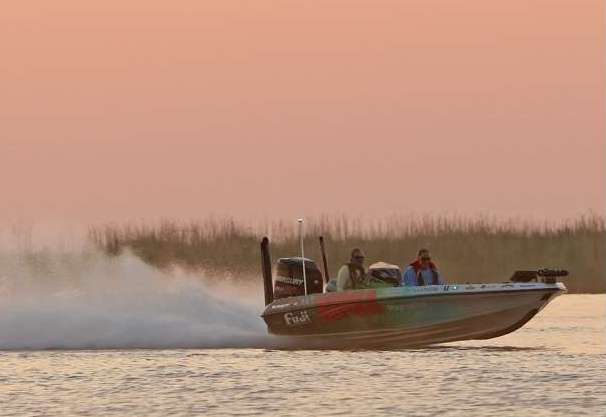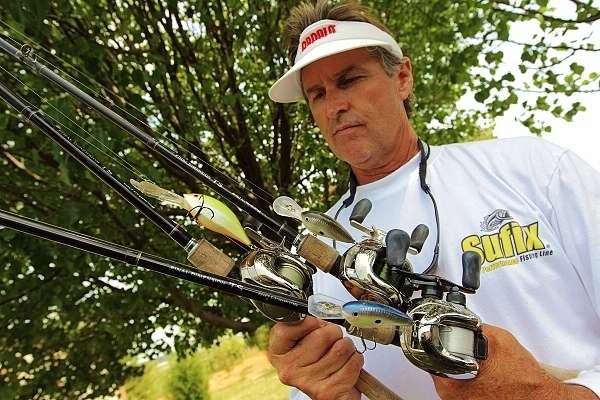
At 4 a.m. an alarm sounds. Time to get up!
With sleep in your eyes, you stagger to the bathroom, wash your face, brush your teeth, then scan the room for anything you might need for the day.
As you dress, you listen to the Weather Channel — hot with no chance of rain.
You keep moving, thinking … your competition is already ahead of you.
It’s now 4:30 a.m. and you still have to stop for ice, drinks and fuel before you can complete the 20-minute drive to the lake. You unplug the power cord to your battery charger, remove the boat cover and load your gear. Once that’s done, you pull the entire rig forward and layout a couple of traffic cones, hoping they’ll secure your parking spot until you return.
After a quick stop at a convenience store, you’re finally heading to the ramp — radio on — hoping to catch the scores from last night’s game, or hear details of the latest political scandal. Neither of which really matter. It’s just a way of staying connected to the world while waking your mind.
On the water
When you reach the boat ramp, you’re third in line. You get out, undo the trailer straps, remove the transom brace, check the drain plug, do a once around, then slowly back the boat into the water. With the truck in park and the emergency brake engaged, you hop in the boat, power it off the trailer, then beach it with Power-Poles anchored.
Back in the truck, you find a parking spot (hopefully with some shade) then grab your hat, buff, sunglasses, cellphone and anything else you may need for the long day ahead.
It’s approaching 5 a.m., and there’s just enough light in the sky to make out the distant shoreline. You power up your electronics, apply some sunscreen, then set out for your first stop of the day.
As you cross the lake, its surface is like a sheet of glass. You notice the faint flicker of running lights from other boats in the distance. There’s no time to waste … your competition is ahead of you.
Your first stop is to a row of docks. Expecting a shad spawn, your initial casts are with a spinnerbait. You get a quick bite — a 2-pounder. The next 20 docks bring nothing.
Now the sun is well above the trees, the temperature is climbing fast. You hydrate then look for a shaded bank, thinking there may still be a shallow, shoreline bite.
There’s not. It’s time to look deep.
Relying on your electronics, you move from point to point, break to break, hoping to find some unique subsurface feature holding a school of bass. In two places, you get bit. Nothing big, but, again, there’s hope. Then the phone rings. It’s a sponsor asking to book you for an appearance. You agree to the date then return to the task at hand.
After two more hours of searching deep, your confidence begins to wane. “Where are they?” you ask.
You go even deeper, but all your electronics show are vague images of scattered baitfish and blank structure. You call a fellow competitor to compare notes. He’s having a tough time, too. He tells you he’s talked with others who claim the same. It eases some of the frustration but, deep inside, you know somebody is finding them … your competition is ahead of you.
It’s now early afternoon and the temperature is 95 degrees with a heat index of 105. There’s no breeze and you’re soaked in sweat. The search continues.
Switching gears
It’s now 3:30 p.m., and all you’ve found are a couple of schools of keeper-size fish. Nothing that will get you paid.
You decide to scrap that and move up the reservoir to its headwaters. Halfway there your thoughts drift: You ask yourself, “Why am I doing this? I’ve had so many bad tournaments in a row. When will things turn around?”
When you reach the headwaters, you find others already there. There’s a boat every 100 yards.
You squeeze in, hoping the move will pay off. It doesn’t. There’s too much pressure … the fish have backed off. Still, you try a dozen different baits, hoping something will click.

It’s now 6:30 p.m. The sun is well above the horizon and it’s still boiling hot.
Finally, you get a good bite … a 4-pounder strikes a square-bill next to a snag. You immediately look for others like it, and, when you find them, you score again. It’s a pattern! But it seems to be limited to the handful of snags you’re able to find in current. You spend the remainder of the day running to the backs of major creeks, hoping to find more like them.
By 8 p.m., the sun is gone. Your search is done. It’s time to head in and gas the boat, then grab a quick meal before bedtime. During the drive, you ponder what you should try tomorrow. Then the phone rings. It’s a welcome voice from home, wondering how you’re doing. Instantly, it becomes the best part of your day.
After the call, you meet up with a couple of other pros at a local diner. After that, it’s on to the hotel to secure the boat. Thankfully, your cones are still in place. You back the rig, hook up the charger, secure the boat cover then head for a shower.
By the time you’re in bed, it’s 10 o’clock. You check your emails, then check the Weather Channel forecast — hot with no chance of rain.
Exhausted, you set your alarm and call it a night … knowing tomorrow will come soon. As you drift off, your final conscious thought is … your competition is still ahead of you.
Follow Bernie Schultz on Facebook or through his website.


